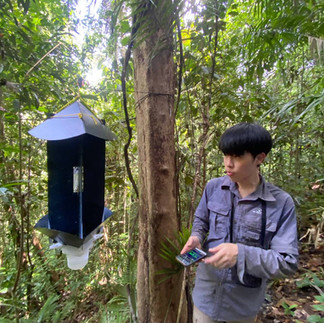SCIENTIFIC EXPEDITION: EXPLORING BRUNEI DARUSSALAM'S BIODIVERSITY
- Sean Yap
- Jun 21, 2024
- 3 min read
Recently, TEE lab members Sean (me!) and Calvin participated in the scientific expedition: Exploring Brunei Darussalam's Biodiversity, organized by by the Forestry Department, Ministry of Primary Resources and Tourism, Brunei Darussalam and Universiti Brunei Darussalam. The expedition took place at the Batu Apoi Forest Reserve, a mixed dipterocarp forest in the Temburong District, from 30 May to 8 June 2024.

The primary objective was to systematically collect and document floral and faunal biodiversity, particularly in pristine forest areas unaffected by human interference. Two main transects were opened for research - a primary forest transect, and a transect in a plot of forest that had been logged about 20 years prior.
As two out of the ten research leads for the expedition, we each led one research team over the field expedition days. Both our research involved documenting of insect taxa in both primary and logged transects to provide initial species checklists and to compare diversity between forest types. While my research focused mainly on Scarabaeine dung beetles, Calvin's focus was on saproxylic insects.
To study saproxylic insects, Calvin employed two main methods. At each study plot, he used hanging panel flight intercept traps baited with ethanol to collect flying saproxylic insects. He then also collected leaf litter, which were brought back to the campsite and hung up in winkler bags for extraction.

One of the major challenges when working at the base camp was the rain, and the muddy conditions. At times, the winkler bags were completely waterlogged, and the outdoor lab floors were flooded, but everyone worked hard and pushed through!
In the days after setting up his traps and winkler extraction bags, Calvin also did some opportunistic collection of saproxylic insects, including checking inside fallen logs along the transect and surveying around the artificial lights in the campsite at night. These opportunistic searches, while not included in the data from his systematic sampling, yielded some very interesting species. Some of the more interesting records were even found in our living area!



For my own dung beetle sampling, I employed dung-baited pitfall traps and ground-level flight intercept traps.



Some of my favourite bornean species: Catharsius dayacus (left), and Copris ramosiceps (middle, right)
On clear nights, we also had the opportunity to survey nocturnal insects via light trapping.


Some of the visitors included stag beetles, a female atlas beetle, and longhorn beetles.


Our trap was also visited by a vinegaroon with a red telson, and I was joined by a flower-visiting longhorn beetle in the shower that night.
During the VIP visit on day 6 of the expedition, the NTU team also got to meet with the minister of primary resources and tourism, as well as a team of foreign delegates including the Singapore high commissioner to Brunei Darussalam, Mr Laurence Bay. We talked about our research and collaborations in Brunei, and even let Mr Bay handle a live stag beetle.



We are grateful to everyone in Brunei from the university to the forest department and forest police who helped make us feel at home in the expedition and for helping us with so much of the logistics needed for the research.
Overall, it was a great experience and many new friendships and potential collaborations were forged. We are still working on the data from the expedition and looking forward to publishing with our collaborators from UBD and the Brunei Forestry Department!









































Comments